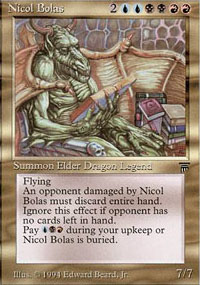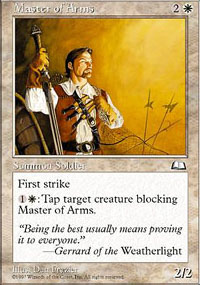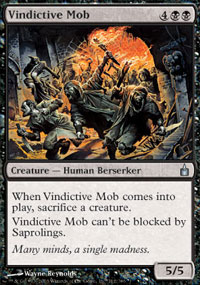Boy, what is MaRo thinking?!
We've all seen these outcries. Some of us are still reeling from the announcements of early June. I was just as worked up as anyone after reading that insane laundry list of changes. Yet, oddly enough, in spite of all these horrible past decisions WotC has made with the express goal of destroying one of their most profitable franchises, the game endures, even prospers.
Wow, MaRo must be some sort of evil genius!
Okay. First of all, contrary to popular belief, MaRo is not the nefarious mastermind behind every decision in the Magic line. He's only the lead designer and a company spokesman (and a very approachable guy—I actually met him at Comic Con. He liked my Weatherlight articles. It was awesome).
But second, while we all remember the initial emotion about these decisions, seldom do we take a look back and see how they turned out. Some controversies were stronger than others, but every little change has elicited calls heralding the 'death of the game.' The internet, after all, puts a microphone in front of everyone.
So who wound up being right? Let's look at some of the biggest controversies, a personal estimate of just how angry people got about them, and finally, how they all turned out.
July 1995 – Chronicles. Outcry Level: 7/10
The first real scandalous release, the idea behind Chronicles was a noble one: to make some of the interesting older cards available to newer players. I mean, some of these cards were almost two years old—almost historical relics! An entire new generation of players (including a very young VestDan) got its first access to the Urzatron, Ernham Djinn, Elder Dragons, City of Brass, and the like. That, however, was the problem.
See, back in 1995, Magic had a very different customer base. As the first several expansions had exceedingly low print runs, individual cards gained very high values very quickly. This made Magic seem very friendly to collectors, who spent a bunch of money on flashy things like the Elder Dragon Legends. When those cards were reprinted, the value of the earlier versions plummeted; as it turned out, the cards weren't really

I used to be worth $80!
That's okay. But can you believe
my crappy cousins were too?
WotC actually responded to this objection in short order. They created the Reserve List, a list of cards from each set that they promised never to reprint again (the list hasn't received new additions since Urza block, but they still haven't reprinted any cards on the list. Well, other than all the uncommons they took off the list).
I don't recall any direct statements to this topic, but WotC for a long time implied they would never release a Chronicles style all-reprint expansion again. Yet, that's exactly what the very popular Time Spiral timeshifted cards amounted to. Now, the total number of each timeshifted card is pretty low. Unlike Chronicles, reprints didn't flood the market. But the real lesson here is that the value of most of these reprinted cards actually increased. The singles economy is not what it was in 1995: card value is based far more on playability now than scarcity.
Net result: Neutral. Chronicles made a lot of cards and concepts a lot more accessible to a lot of early players. However, it damaged the early game's profitability, damaging the collectible aspect of the game. The bad taste that left still leads Chronicles to be considered a failure, but the thriving singles market eventually just adapted to reprints, instead of collapsing.
1995ish - Type II. Outcry level: 7/10
(My memory on this is a bit sketchy, so I apologize if I'm not as accurate here)
As the Power Nine and other defining cards became harder and harder to come by, affluent players bore a distinct advantage over those without a budget, or those just starting out. If you think getting Bitterblossom or Tarmogoyf is difficult, imagine having to get Ancestral Recalls to be competitive! The cards were obviously too powerful to ever print again, but they remained part of the environment and made any sort of organized play ridiculously unfair. So the Duelist Convocation (later adding "International" to the end, prior to simply becoming the non-acronym DCI) decided to create a second, rotating format. Meaning that your cards would become unplayable after a few years.
This was not a terribly popular concept. While hardly anyone ever hoped to actually own Power, it still seemed like a core aspect of the game. I mean, they were legendary—just seeing a Black Lotus was an incident of note. Thinking of a game where you couldn't be Time Walked over was like finding out you couldn't ever have cookies when you grew up. Woe!
Net result: Positive. The logic behind the decision was that non-rotating formats are not healthy/varied enough for the bulk of the audience. Type II, now called 'Standard,' was eventually embraced, and is now the dominant format as all the cards are readily available.
As demand for other environments arose, Legacy, Block, and Extended were all split off, and it sounds like 'make your own Standard' may get sanctioning at some point as well.
June 1998 – Exodus template. Outcry level: 4/10
Other than a few tweaks and production improvements, Magic cards had looked the same for the entire half-decade the game existed. But by this point, a huge number of other card games had come out, and several of them were clever enough to include more useful information on the cards than Magic did, such as collector numbers and card rarity. With Exodus, WotC decided to update the card template to include this information, with collector numbers and artist information now centered on the bottom, and the expansion symbol now color-coded to rarity. Believe it or not, a small but vocal group objected to this change, saying it was unnecessary, it made the cards look cheaper, and other such nonsense. The outcry wasn't huge here, but the fact that there was one at all for such a straightforward, reasonable alteration just goes to show that someone will always complain.
Net result: Positive. Collecting sets is a breeze when everything has a convenient number, and trading is much more easy and fair when it's clear what rarity cards are.
February 1999 – Foil Cards. Outcry level: 2/10
Likewise emulating success in other games, Magic added foil premium cards starting with the Urza's Legacy expansion. Many complaints were the along the same lines: just because other games do it doesn't mean it's good, it's just blatant capitalism, etc. This was really a small group of angry people, as the change was so small and most people were fairly ambivalent.
Net result: Neutral to Positive. Up through Scourge, foils were popular with a small group, but never really took off, largely because the foiling technique left out the most relevant visual part of the card: the art. Once they figured out how to selectively-foil the art, foils went from merely being shiny to downright spiffy-looking. While it's hard to measure the actual impact foils have on sales or enjoyment, it does please the crowd that likes to pimp their deck, and does so at no expense to other players.
April 1999 – Sixth Edition Rules. Outcry level: 10/10
Here's the big one. After six years, they completely rewrote the rules to the game. Entire card types ceased to exist. Spell-trees and other mnemonics

After nine years on milk cartons and
Unsolved Mysteries, Master of Arm's
functionality was finally found and
safely returned. Master of Arms would
like to thank you all for your love
and support.
It cannot be understated how major a change this was. It took many old-timer players (myself included) years to relearn the game they loved. It also cannot be understated how livid players were about this fundamental change. It was a pain, it was disruptive, it was less flavorful ('Creature' instead of 'Summon'? Blasphemy!) and most frustratingly of all, there was no reason for it at all!
And worse, this came coupled with a terrible core set. Beloved favorites like Sengir Vampire and Serra Angel, taken out of Fifth Edition for being 'too powerful,' were still absent, without anything strong or iconic replacing them; worse, trample and protection were taken out entirely as being 'too complicated' for a core set. How dare they dumb down the game, just to appeal to the Pokemon crowd?
While Classic Sixth edition was a terrible (and ironically named) core set, the rest of those complaints were mostly short-sighted nattering. By this point, WotC realized that while some players were in it for the long haul, most only played for a few years. Other games had come out that were challenging Magic's dominance, particularly with the younger crowd, largely because of the complexity of Magic's original rule set. Streamlining the rules made it easier for new players to pick up and made it easier to figure out how cards printed years apart interact.
The bigger charge was the 'dumbing down' of the game, which the removal of trample and protection from the core set only underscored. While there was an intentional change towards general simplicity here, it took some time for players to accept that this didn't preclude overall complexity. Even so, WotC has scaled back the simplicity of the core sets, allowing more complex cards at rare, trample and protection at uncommon (with reminder text), to introduce the concepts to new players without overwhelming them.
Net result: Extremely Positive. The older rules worked, of course, but the question is 'how well?' A large number of older players—even those complaining about the rules change—didn't understand how the rules actually worked. When you could cast interrupts, the damage-prevention window, etc. You would be hard-pressed to find anyone now who would say pre-Sixth rules were superior, and I'm quite willing here and now to call those rare folk idiots.
June 1999 – Evergreen Reminder Text. Outcry level: 3/10
This was a minor annoyance for a lot of older players. Of course only other flying creatures could block flying creatures! Of course "Wall's can't attack"—easily the most hated bit of reminder text. Thing was... people kept making that mistake.
"Well, they should just read the rules then!" would be the reply, followed by mutters about the rules having just changed. Honestly, much of the vitriol about this change was leftover anger about the Sixth Edition rules overhaul. I, personally, felt a little annoyed every time I was informed that "Walls can't attack," yet no longer having to explain that Carnivorous Plant was only a blocker was a nice bonus.

Feed me, Seymour!
October 2000 – Magic Online. Outcry level: 7/10
At the same time WotC released what would become one of the most popular sets of all time, they opened up an entire new venue for the game: the internet. Programs like Apprentice and Magic Workstation had allowed free online play for some time, and the Shandalar game and Magic Interactive Encyclopedia were both official attempts to cash in on this part of the market. But once WotC finally hit upon a dedicated online play mechanism—Magic Online—they withdrew any remaining support or recognition from the other programs and pushed MTGO hard.
Nobody wanted this. You could not find anyone who was enthusiastic. But you could find plenty of players who were incensed—a few of them still are. You mean I have to pay full cost for digital cards that I can never touch? You mean you want me to play against some anonymous jerk in Europe or Asia instead of actually interacting with another player? And, seriously, full MSRP for fake cards!? It looked to many like a blatant money grab.
WotC stuck by their guns, and players stopped complaining. MTGO's audience slowly grew, and now it's quite the success—and those people who bought a bunch of Invasion block made off like bandits. The MGTO model never changed—you still have to pay for the virtual packs—but enough people have found this desirable or convenient enough to make it a cash cow.
Net result: Positive. Like a lot of the other changes people nattered about, this never much impacted the game itself. If anything, the proceeds from MTGO have allowed WotC to keep their costs down for longer, which doesn't hurt. Further, it allows players to test against a global metagame at any time, day or night, and provides a way for players in remote areas some way to play when they can't find a game locally.
2001 – Reduction of Storyline. Outcry level: 4/10
After ending the epic Weatherlight Saga, WotC declared that it would be phasing out the strong story-to-set connection. Cards would merely evoke a setting, but other than legendary cards wouldn't reference the story.
Some players liked this decision—quite a few people were tired of seeing Gerrard's mug everywhere. Yet those fans of the storyline were heartbroken, not only from the implosion of the Weatherlight Saga, but at the knowledge that they would never see a story told in that way again. Worse, the story we were given was hardly an interesting one. Kamahl's saga was really a non-starter, and the less said about Onslaught block's storyline, the better.
Net result: Neutral. This one is more a matter of opinion. Some players love the Tempest model, where you can piece together a storyboard out of the cards; others prefer the Ravnica model, where you can't tell what (if any) story is going on, but the cards do a great job of evoking the setting and factions involved. This second model is probably harder to do—or can you look me in the eye and tell me that playing in Kamigawa block really felt an all-out Spirit war?
July 2003 – Eigth Edition Card Frame. Outcry level: 9/10.
Here's the second most scandalous decision on the list, and all the more interesting because they revealed the intended change a full year in advance. That's right—there was an entire article showing the new card frame and saying why they were going to do it. It wasn't widely publicized, however, and the change was so drastic that players seem to have ignored it as some sort of odd joke. When Eighth Edition finally started rolling out, people went insane. Riots broke out in downtown Los Angeles. Looting and burning was followed by nuclear war, and the destruction of the moon.
People hated the Sixth Edition rules change because it was 'dumbing down' the game's rules to be like other games. They hated the new card frames because they 'dumbed down' its appearance in the same way. It looked like the Windows ME version of Magic. It lost the fantasy element core to the game. MaRo was reported to Interpol to be tried at the Hague. He remains at large to this day.
That was a bit much perhaps, but the extent of the change was incredibly drastic. A casual observer wouldn't be blamed for thinking a card from Eigth Edition was from an entirely different game than a card from any previous set.
Net result: Positive. There's still a few detractors out there, but five years on we've gotten as used to the modern frames as we were to the old ones. In fact, the original card frames look a bit dated now—more stylized yes, but not as clean and crisp as the modern frame. This is another one that is subjective and hard to measure, but Magic's big face lift lets it fit in among the modern CCG market.
October 2005 – Pro Player Cards. Outcry level: 6/10.
This was another one of those 'much ado about nothing' moments. The big outcry was that they were spending this money to create this pointless, annoying advertisement cards for the Pro Tour. Couldn't they just make the packs cheaper?
WotC has always been pretty good letting the players know ahead of time of any changes coming up. This might have been an occasion to have just gone ahead without comment. It wasn't so much the concept of the Pro Player cards that created the furor as the way it was posed—in the usual effervescent, overenthusiastic magicthegathering.com manner as if it were

What kind of 'joints'
did you think I meant?
Net result: Neutral. Once they apologized for how they came out with the idea. People grumbled about it for a while, but like foils and such, they found their niche audience and everyone else ignores them.
May 2007 – Neo-Walkers. Outcry level: 4/10
Another mostly-storyline complaint, this was even more fundamental than never doing a saga again. Nigh-omnipotent planeswalkers had been around for the entire history of the storyline; depowering them into merely very-strong spellcasters not only cheapened them, but removed one of the defining elements of the Magic multiverse. It also paved the way for the new planeswalker card type, which the old-school story types are still rather bitter about.
Everyone else, however, loves how the 'walkers play. They were heavily playtested, quickly accepted, and have become the main focus of the current era of the storyline. These guys have been rebranded as the new faces of the game, and they're flashy enough to carry the brand with few appearances instead of a long, detailed epic. It appears we shall at least get a long-term continuity again with these guys, though it remains to be seen if the planeswalkers will actually be involved with the storyline of your average block.
Net result: Neutral to Positive. The Vorthoses have learned at this point that their numbers are just too few for anyone to particularly care what they want, no matter how loud they scream. As a writer, though, I can see WotC's motivation here: it's incredibly hard to keep omnipotent characters interesting.
So, given that trip through history, let's look again at
June 2008. Outcry level: 8/10
There's something here for everyone to hate. Mythic rares. Basic lands in booster packs. The death of prereleases. Massive changes to the publishing line. Theme Decks replaced with Intro Packs. Rarely has WotC clustered so many sweeping changes in so short a time. Look back at 1999: they had several changes, but gave the players time to digest each. They decided to go an alternate route this time, and boy were we pissed off.
Then people read MaRo's article about the changes, and it did an unusually good job of soothing most worries. Perhaps I just don't listen to the complaining as much, or perhaps he was as convincing as I think, but after a week or so most people have settled on a 'wait and see' attitude. It remains to be seen how well these decisions will pan out; basic lands in all booster packs still seems like a ridiculous idea to me. (Heck, they should just give the basics away, it'll just make new players more eager to buy more cards.) But

This card used to be both civil and
playable until it found out it was
packaged with Pro Player cards.
That being said, the sheer scope and number of changes this year is unusual, perhaps unprecedented. Each change is fundamental, and there are changes across the entire product line, from formats to tournaments to the novel line to the actual contents of packs and sets. It could be they have thought every bit of this through for some time, and unroll it all now to make it a clean change that we'll resent this year and enjoy the fruits of thereafter. Or perhaps it's a retool in response to the crappy economy—WotC has even recently cut staff. These sorts of things can be necessary for companies to survive bear markets, and I think we can all agree that we'd rather Magic adapt to change than be competed out by video games and internets and what-have-you. Or perhaps there has been a change in administration within the parent company who has a different vision for the line—which sometimes works. Point is, there's no knowing how any of this new stuff will turn out, but we do know from the cancellation and subsequent reinstatement of States that somebody there is paying attention.
There will always be a vocal contingent, decrying the end of days with every major decision WotC makes. This is human nature. Some people, who have trouble learning from history, equate 'change' with 'destruction,' which of course isn't fair. Yes, all these decisions represented some change in something we players love, but Magic, at its heart, needs change to survive. It's that dynamic element that makes the game—and the CCG industry, really—so unique. So next time WotC puts out a surprise press release, try to remember that these people are professionals, and any drastic decision they make is aimed toward some concrete, positive goal, and made only after months of thought and examination. In other words, chill.
…but seriously, MaRo. Keep those ******* basic lands out of my boosters.
Comments